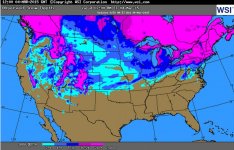TR
"You can observe a lot just by watching." Y. Berra
Good morning.
The Catskills as of this morning, Wednesday, March 4 2015, have more than 24 inches of snowpack.
Some higher elevations in shade have in excess of 30 inches.
Ice is now over 24 inches on pools in rivers.
Notice on map of 3/5/15 that Central Jersey (2 hours to south of us) has less than 6 inches in places.
It might change after today - Philly / D.C. is expecting 6 to 10 inches.
Below freezing nighttime readings are forecast for most of March 2015.
Be safe.
See you at the show.

Intellicast - Snow Cover in United States
The Catskills as of this morning, Wednesday, March 4 2015, have more than 24 inches of snowpack.
Some higher elevations in shade have in excess of 30 inches.
Ice is now over 24 inches on pools in rivers.
Notice on map of 3/5/15 that Central Jersey (2 hours to south of us) has less than 6 inches in places.
It might change after today - Philly / D.C. is expecting 6 to 10 inches.
Below freezing nighttime readings are forecast for most of March 2015.
Be safe.
See you at the show.

Intellicast - Snow Cover in United States
